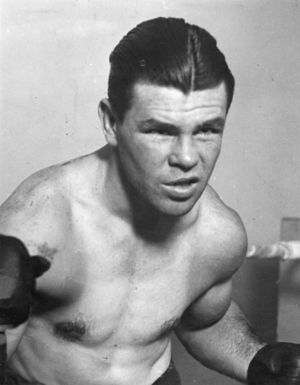The Great Mickey Walker
By Kelly Nicholson
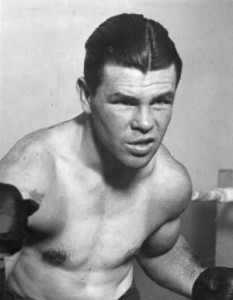 The world, by heaven, had a fighter on its hands when Edward Patrick Walker made his way into it on July 13, 1901. “I was born dead, with a black eye,” he recalled, “but even that early, I must have been too stubborn to quit.”
The world, by heaven, had a fighter on its hands when Edward Patrick Walker made his way into it on July 13, 1901. “I was born dead, with a black eye,” he recalled, “but even that early, I must have been too stubborn to quit.”
Edward, who would be known to the world as Mickey, got the details of this event when he was 21 years old and had just won his first world title. At twelve pounds, he learned, he had been no small chore in the delivery room for his mother Elizabeth. The doctor had to employ some instruments and do some tugging (hence the eye) to bring him into the light of day.
Yet Edward at the moment showed no signs of life. After shaking, spanking, and massaging the new arrival, and trying to breathe air into his mouth, Doc Timothy Reilly sadly set him aside and tended to the mother. A few minutes later, Elizabeth was revived, whereupon Edward, to Reilly’s amazement, let out a howl. New Jersey and the Walker family had a new member.
It was a fitting entrance for a kid who would soon have a rep throughout the Keighry Head section of Elizabeth, New Jersey, as a young gamer who would never say die. Sporting long golden curls and dressed by his own description in “a Little Lord Fauntleroy outfit,” he had plenty of chances to display that part of his makeup in his early years. In her innocence, it seems, Mrs. Walker thought that such prim and proper attire would keep him out of fights. (“I’d have been better off,” said Mickey years later, “if she had given me brass knuckles.”)
At Sacred Heart School, Edward was a bright student, and a curious mix, as he would always be, of virtue and vice. He refused to steal in any circumstance, yet had no qualms about coming to the rescue of a friend who fudged constantly in the local craps games. He was no bully, but his hair trigger temper had him in scuffles time and again. Soon he was the toughest kid in Keighry Head, and so also the inevitable defender of neighborhood honor when anyone from outside came looking to challenge it.
At 14, an expulsion from school sent Edward into the work force. His first meaningful job had him running errands for an architectural firm on Park Avenue. Within a year and a half, however, his innate artistry surfaced and he was lending a hand with the drawings. When a dustup with a co-worker (the fellow, it seemed, had engineered a prank that sent Edward running around town to retrieve a supply of radium) put an end to that assignment, he wanted to join the war effort by way of the U. S. Navy. In his mid-teens, however, he was shy of the requisite age, and Elizabeth was not about to help him hide the fact. In the next six months he had a slew of jobs, usually cut short again by scrapes of one kind or another.
* * *
In July of 1918 Germany signed an armistice, and a wave of returning young veterans was soon swelling the competition for what work was available. One day, sucking a cigarette and leaning against a lamppost in the old neighborhood, young Ed chanced to see a poster advertising a boxing show at the local athletic club. New Jersey had recently legalized professional fights, and the thought gripped hold of him with life-shaking force: He would be a prizefighter.
At the time, he had never seen a professional fight, despite his lengthy resume in the street. At a modest 5’6 and 118 pounds, however, he admired men who could make the most of their natural gifts. A few months later he would find an idol in new heavyweight champion Jack Dempsey when Jack slashed his way to victory over a towering Jess Willard. But with this new undertaking came an adjustment, for everyone now was bidding him to train – strange advice, it seemed, since he could always hold his own in a quick set-to when the occasion arose. But he would soon see the difference between three minutes in the street and three minutes in the ring.
He would also learn fast a thing or two about technique. Ed was without a rudder in his first days at the Elizabeth YMCA gym until he was persuaded to spar with a local youngster of the same size. Scarcely had “time” been called to start the action when he found himself on the canvas, courtesy of a right hand from his partner. There ensued a brief donnybrook that was quickly terminated, and once outside the ring he was introduced in proper fashion to his opponent: He had just traded leather with Dominic Orsini, a local prospect from Elizabeth’s Italian Peterstown section who was making a name for himself lately around Jersey and Staten Island.
It so happened that the matchmaker of the Elizabeth Forester Athletic Club was on hand, and he persuaded the freckled novice to take on Orsini at an upcoming show. In the next few days the impending clash of the Italian kid and Irish Thunderbolt Mickey Walker kindled ethnic feeling that figured to erupt on a grand scale when the action heated.
The fight, while it was only a four-rounder with no decision rendered, was a barnburner. It was an ordeal in spades for Mickey: Having gorged himself earlier on raisins, he was queasy midway through the first frame. He was also burning from the “secret formula” (it was actually horse liniment) slathered on him in the dressing room by his young makeshift manager Oscar Lamb. In the second round, he was darting around the ring in an effort to stay cool and trying to keep a mad sweat from flooding into his eyes.
The bout, claimed Walker years later, was conspicuous on one other count, owing to the fact that his mother, at one point, had to be retrieved from the roof, where (with women barred from actual attendance) she had positioned herself to look through a skylight. In the third round, tossing shadow punches of her own in maternal excitement, Mrs. Walker struck the glass, sending broken shards down onto the proceedings and bringing attending cops into action.
At the end of those four rounds, each kid had given his all. And good feeling prevailed, both in and out of the ring, at the close. The Peterstown boys themselves, in fact, took Mickey into their fold as a result of his effort. No such affection was present afterward in the dressing room, however, where Oscar insisted afterward on keeping his “manager’s 20 %” cut of the ten-dollar purse! (When Oscar shot out of there, Mickey went after him – sans towel and down the street running stark naked after two dollars that he never did get.)
Eight bucks was not much for that ordeal, but local scribes were now calling for more. Mickey, it was said, had some of the fleetest footwork seen in years – little did they know the real reason – and showed promise as a fighter. One other thing weighed into the bargain, as well: At 17, Mickey Walker now had a respect in the neighborhood that he had never known. Through the connection of an uncle from the Higgins side he joined forces with former amateur athlete and distance runner Johnny Anthes, who tended to the details of Walker’s training and ring education. Often Anthes accompanied Mickey on ten-mile outings before going to the back of his confectionary store to show him the fine points of the trade.
Handspeed and heart, Grantland Rice once said, are what boxing is all about. Mickey had the speed, and his gameness extended like a ray of light into eternity. He also had a mean right hand and a terrific left hook. The strength on his left side, he always believed, owed something to a childhood collision with a motorcycle that broke his collarbone – fearing that the injury might derail his chance to become a big league ballplayer, he started to work overtime with the left hand, becoming ambidextrous and able to bat with power from the port side of the plate. He would soon get a chance to use both those hands against New Jersey featherweight champion Jimmy McCran. When he flattened McCran in two rounds, Mickey gained his first ecstatic taste of celebrity.
Despite a KO setback against a fierce young hitter named Phil Delmont, or maybe because of it, he bore down yet harder in the months that followed. Ferocious sparring sessions with another Higgins uncle soon inured him to trading at length with a bigger man. Miles pounded out on the soft sand of Staten Island gave him legs that knew no limit. A slam-bang decision win – meaning, at the time, a rough consensus of the local writers – over hard-hitting Benny Cohen, who was being groomed for a world lightweight title shot, had him verging upon national acclaim.
At about this time he and Anthes went their separate ways, a parting that Walker would soon see was for his own good. Anthes, loyal but low-key, was not cut out for the big time. Mickey took on Newark matchmaker Jack Bulger, another solid type with both feet planted on solid ground. Honest to his bones, Jack fancied the bright lights of Broadway, but business came first.
In 1921 Mickey was a welterweight who had proved himself over the course of 40 fights. The only clear loss on his record was the one to Delmont. On July 18th, he took on world welterweight champion Jack Britton in an over-the-weight twelve-round bout with no change of title to be forthcoming if it went the distance. Britton, who had won the title from Ted “Kid” Lewis four years earlier, was widely counted as one of the shrewdest ringmen alive. But Bulger believed that he was ripe for the taking.
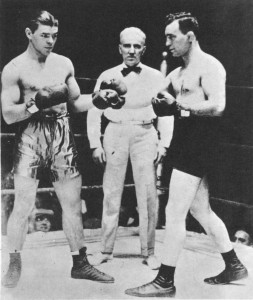
Britton, however, had other ideas. The champion, said Mickey, “must have caught up with his second childhood that night. For eight rounds I saw more boxing gloves and tasted more of them than in my whole boxing career up till that time.” Even as he faded, late in the fight, Jack kept up a verbal harassment in close, goading Mickey into loading up with punches that he could see coming. After twelve, the newsmen were divided. And Mickey had gained serious ring education.
The remainder of that year and 1922 saw him plenty active until he met Britton again, for all the marbles, on November 1st at New York’s old (23rd Street) Madison Square Garden. The time was now right, with Jack a shopworn 37 years of age and Mickey a well-seasoned 21. Walker, who reveled in the comparison of himself with heavyweight Jack Dempsey, tonight lived up to it. While Britton’s savvy kept him in the fight, round after round went to the challenger.
Floored several times in the bout, thoroughly whipped by the end of the tenth, Britton still would not fold. By the twelfth round the referee was asking him to concede. And still Jack stayed to the end. When it was done, he offered with no excuses. Showing not a trace of bitterness, he raised the hand of the new champion in sporting fashion and offered only gracious words: “You’re a good kid, Mickey – hope you hold it as long as I did.”
One Sunday after Mass, Mickey met young Maude Kelly, the stunning little sister of one of his acquaintances in the training camp. In June of 1923, they were married and rented a house across from the Walker home in Elizabeth.
* * *
In June of 1924 Mickey defended the title against Lew Tendler, rival of the immortal lightweight champion Benny Leonard, who once had Benny momentarily out on his feet in the middle of their own title fight. In front of 18,000 at the Phillies’ ballpark in Philadelphia, he won a decision with the referee giving him eight of the ten rounds.
Mickey was now a phenomenon – a competitor, they said, reminiscent of Barbados Joe Walcott, the sawed-off welterweight who had plagued the higher weight divisions at the turn of the century. In the succinct estimate of one New York correspondent, “Walker is a fast, game, and explosive hitter and revels in a bristling contest. A stinging punch fires him to redoubled fury. That is the mark of a thoroughbred fighter.” (Beloit Daily News, 10-20-24)
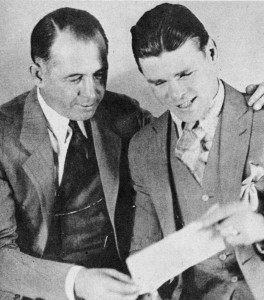
After the passing of his father and later his manager Jack Bulger, Mickey took up with a very different sort, the legendary Jack “Doc” Kearns, a high-living huckster who had guided his idol Dempsey to the heavyweight championship five years earlier. On his deathbed, having suffered a burst appendix, Bulger had warned Mickey to take care of himself, and not fall prey to the vices that would rob him of his natural gifts. But now the floodgates of wine, women, and song swung open. Training in Hollywood, Mickey struck up friendships with eminent film stars – and some of the most fabulous women in the entertainment galaxy. When Kearns found him in a compromising position with one hotel playmate, Jack moved the operation north to San Francisco, bringing aboard a no-nonsense trainer who would get Mickey back into a semblance of condition.
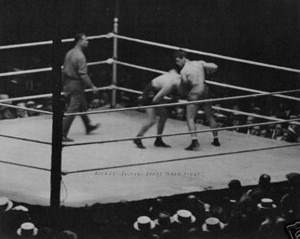
Doc had a keen eye for talent and a mind’s eye knack for knowing a good fight when one was in the offing. He also knew how to wrangle fights for the men he managed. On July 2, 1925, arguably the greatest two-man package of middleweight talent ever put together climbed into the Polo Grounds ring when Mickey (albeit still a natural welter) challenged Harry Greb for the middleweight championship. Perhaps also, this fight united the sport’s two greatest imbibers, even if Mickey did not yet have the depth of commitment to the activity that Harry did. Before 65,000 fans, the two men whaled away, street tactics – and here even Mickey had to take a back seat – figuring plenty into 15 rounds of action. In the fourteenth round, a Greb right hand haymaker had Mickey in a daze, and he took a drubbing (he would always claim that the rally started with a blatant thumb in the eye) until the bell. In the fifteenth, one eye swelled shut and the other barely open, he stood his ground until it was over.
Harry got the nod, but according to Walker (this is an old tale, oft voiced and much debated), the action did not end in the ring. At about one in the morning, the bruised challenger left his quarters at Park Hotel Central and managed to find his way to LaHiff’s bar in order to meet Kearns (owing to a suspension, Doc had not been allowed at the fight) down the street. Once inside, and trying to get to his manager, he came upon Greb instead, sitting at a table with two gorgeous friends. For a second it was a tense scene. But Harry defused it when he said, “Mickey, have a drink with some friends of mine, will you?”
All was well for most of the night, the two young turks regaling each other brags and tales until even the shapely dames had left and the joint closed at three o’clock. Walker suggested that they hit an establishment called the Silver Slipper, where the hardcore faithful were better accommodated. Things were still amiable as they walked up 48th Street, but as they neared the Slipper, they began to argue about who was truly the better fighter, all tricks aside. The debate escalated until Greb at last announced his intention to repeat, then and there, the lesson he had administered awhile ago.
At which point, Walker would maintain, the street-savvy champion made one mistake. As Harry was pulling off his jacket, Mickey teed off and knocked him against a taxi cab next to the curb. Harry righted himself and the two went at it again, with a small band of night owls gathering to get a free version of what had transpired a few hours earlier in the ring.
When it was broken up by a cop on the local night beat, Walker felt, as he would say years afterward, that he might have lost the first fight that evening, but not the second. Even so, the two men were friends again before long. Yet this mortal tie ended a year and a half later when Greb, days after rolling his car in an accident, had a nose operation to clear his breathing and succumbed the next morning to complications from the procedure. On hearing the news, Mickey was moved, for one of the few times in his life, to shed tears. Greb, he would say in time, was the greatest fighter he ever saw.
The continuing night life, however, was not doing Mickey any favors, and it showed in the spring of 1926 when he met old rival Pete Latzo, whom he had beaten two years earlier. In that first fight Mickey had gained the moniker The Toy Bulldog, bestowed upon him by an admiring sportswriter who was reminded, in the young Celt, of crazed dogs he had once seen matched in deadly combat. Now, starting his training at 170 pounds, he had to pare down to 147 in order to make weight. In the final two weeks, he resorted to sweating and virtual famine to get there.
At the end of ten rounds, Latzo had the decision and the title. On setting out earlier for Scranton, Walker would say in looking back, there had been a veritable crowd of well-wishers along for the ride; coming back, it was Mickey and Doc, plus the handlers, the only others in their company being former heavyweight champion James J. Corbett and the veteran sportswriter-cartoonist Hype Igoe. Corbett knew what it was like to go through this ordeal and all that came with it. Some 34 years earlier, he had shocked the world by knocking out the hitherto invincible John L. Sullivan in New Orleans. Four and a half years later, to his sorrow, he was succeeded on the throne by his own nemesis Bob Fitzsimmons.
“Look around you now, Mickey,” said James, voicing the wisdom of his six decades, “and see who your real friends are.”
* * *
It was a drastic comedown for a young man of 25 who had been steeped like a bag of black Irish tea in adulation for the better part of a decade. Walker had all but ruined himself in the effort to make weight for the Latzo fight. In truth, he was no longer a welterweight, and the message got home in his next fight. He had been hit hard and often by Latzo, but he got it worse from Joe Dundee in the Garden five weeks later. Fading early, he was cut badly over the left eye and inside the mouth. Dazed, sick from the blood he had swallowed, he was a beaten mess when the referee called a halt in the eighth round.
Now a once-friendly press was calling him washed up, and it damned Kearns no less for allowing the downward slide that had come in the past year. A lot of men would have called it quits, at that point, but Mickey regrouped, with the help of Kearns and a summer break that gave him time to recuperate on the Jersey shore. Before long he was in the gym, ready and willing to test Jack’s conviction that the middleweight division was now theirs for the taking. As a first step, Kearns sent Mickey and a gym mate to Nova Scotia to work ten-hour days as lumberjacks while packing fight training into their spare hours. In October, when he stopped a hard punching hometown Chicago prospect named Shuffles Callahan, Walker’s confidence was reborn. Two wins later, thanks to Jack’s nimble dealing, he received a shot at middleweight king Theodore “Tiger” Flowers in that same Windy City.
Dark as coal, the lightning-fast lefthander from the Deep South had arisen out of earth-humble circumstance to win the title by decisioning Harry Greb. He was the first African American champion after Jack Johnson (his devout manner being cited by many as a contrast to the “uppity” manner of Jack) to win a world boxing title. Unabashedly religious, the Georgia Deacon would recite the 144th Psalm (Blessed be Jehovah my rock, who teacheth my hands to war …”) before his fights. Often he carried a bible with him up the ring steps.
Tiger hit the canvas in opening seconds by way of an overhand right, and Mickey repeated the trick late in the fight. Most of the time otherwise, it was the champion prevailing at long range, though often with slaps and flicks that bordered upon fouls, and after ten rounds, the world had a new middleweight champion. Walker was reborn.
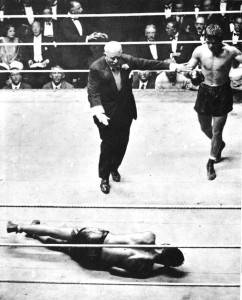
A rematch was precluded when Flowers, seeking to lose the scar tissue from around his eyes, died on the operating table little more than a year after Greb had died in practically the same manner. Walker’s first defense of the title was against British champion Tommy Milligan in London. Milligan was a good fighter, but he was not in Mickey’s league. In front of his home crowd, he bravely carried the fight to the champion in the early rounds. But the champion’s shots to head and body soon took their toll. Down twice in the seventh, Tommy fought back with amazing two-fisted rallies, even with the writing on the wall. In the ninth, he was saved by the bell. In the tenth, he fell again and rose to his feet with nothing left. Walker hesitated, giving referee Eugene Corri a chance to call it. When Corri refused to act, the champion sent the noble young Galahad to the blood-spattered canvas for the count.
On the first of November, Mickey destroyed former light-heavyweight champion Mike McTigue in one round, leaving Mike unconscious for several minutes afterward. Later in the same month, he beat another ex-ruler of that division in hard-hitting Paul Berlenbach. In March of 1928 he nearly won the light-heavyweight title himself in ten torrid rounds with the great Tommy Loughran – it ended with a split verdict for Tommy even though Mickey had gained the edge on the referee’s scorecard. (Loughran, it might be added, had given the young Gene Tunney a lesson in ring craft in their no-decision eight-rounder a few years prior.)
The fighter’s home life, unfortunately, was not on the winning side of his ledger. “Mickey,” it would be said in years ahead, “will not go down in history as one of the world’s leading family men. Cupid has speared him a hundred times and each time the arrow hurt.” (Beloit Daily News, 5-24-32) Maude, even while pregnant with their second child, had finally tired enough of his escapades to file for divorce.
These were precarious years in the ring, as well. Kearns, a wheeler-dealer who could wrangle a deal on the fly when needed, was not always up front with his motives, even with his own fighter. In August of 1929, Walker took on the Pacific Northwest’s noted Aberdeen Assassin Leo Lomski in Philadelphia. Kearns, dickering behind closed doors with promoter Boo Boo Hoff, had earlier made the promise that the fight would end with Lomski on his feet and a credible “draw” verdict declared.
With the hours that Walker was keeping, figured Jack, he would not be able to do much with Lomski, anyway. But Mickey, pouring it on in the gym in the last three weeks, came ready. After nearly demolishing Leo in the first frame, he came back to his corner figuring to have him out of there in the next.
Mortified, Jack now spilled the beans. The fight, he explained, needed to go the distance. Furthermore, he took note, seated near Lomski’s corner was Irish mob boss Owney Madden, who had an interest in Leo and was there to see that nothing untoward happened to his fighter. And so Mickey let it go the distance, but there was no way that anyone was going to call it even at the end of ten rounds.
Days later Owney summoned Kearns to his office. He was double-crossed, he claimed, and there was going to be hell to pay. Kearns, a talker without equal, gave a frantic demonstration of his skill lasting some 20 minutes. He had not tried to double-cross Madden.
Owney saw that he was too scared to be lying. And scared he should have been – Madden was as ruthless as they came. Born in the English town of Leeds, he had come to America at the age of ten and was a legend in his neighborhood while still an adolescent. At 18 he had a reputation with the gun and the lead pipe, and five suspected murders to his dark credit.
Kearns, for now, was off the hook. But thinking still that Leo could whip Walker in a straight-up go, Madden wanted another fight. He also wanted a personal side bet of $10,000 on the outcome. This time, with a full-out training camp, Mickey beat Leo like a rented mule and even Owney, while smarting from the dough he dropped, was impressed.
With Jack, though, one never did know what was up. Mickey got another surprise later that year when he defended his title a second time against the tough Nebraska Wildcat Ace Hudkins. Having licked Ace on points a couple of years back, Walker entered the ring ready to improve on what he had done last time. Round after round, however, Kearns kept telling him to slow up and get the extra work. After ten, Walker had the decision, yet he was still confounded by the nay-saying advice he had been getting in those one-minute installments while seated on his stool. Later, amid a hot exchange, he wrung from Kearns an admission – Doc had not figured Mickey to stay at the middleweight limit too much longer. And having acquired recently an interest in Hudkins, he had been hoping to have him in his stable as the new champion while managing Mickey at the same time!
* * *
Somehow Jack and Mickey stayed together. And together they made things happen. Walker’s record is amazing in its collection of talent – he had phenomenal success against bigger fighters, whom he beat time and again with a mix of heart and savvy and speed. Even so, the ventures were risky and the outcomes could be wild. By 1930, Kearns had his eyes set upon nothing less than the heavyweight championship of the world. That spring he signed Mickey for a fight in Louisville with Johnny Risko, a tough spoiler type who was one of the toughest in the division. When Risko bowed out because of illness shortly before the date, Jack agreed to go instead against the only readily available substitute of any credibility, a 6’3, 220-pound behemoth named Paul Swiderski.
Swiderski, in fact, had worked some with Walker in the gym. When promoter Jack Hurley found that out, he became skeptical about the arrangement and wanted to call the whole thing off. That afternoon he and Kearns were in the hotel arguing the point as Mickey came into the room. At this point, it seemed, nothing would convince Hurley to follow through on the program. So Kearns told his fighter to go enjoy himself.
He didn’t have to tell him twice. Eager to follow that directive, and unhappy with how little these past few weeks of abstinence had now yielded, Walker set out with a handful of journalists on a pub crawl in full earnest.
Back at the hotel, however, the plot suddenly thickened: Kearns succeeded in making a deal with Hurley. Knowing what had likely transpired already in the local watering holes, and desperate for the payday, he went out after his fighter. Several hours later, around eight o’clock, he came upon Walker, by now thoroughly soused, and explained the situation. Mickey, knowing that he and Jack needed the dough, said OK to the fight. A valiant effort was made to get him sober, and ready or not, he went into the ring.
As it turned out, Paul’s experience with Walker paid off – a Swiderski right hand in the first round nearly separated Mickey from his senses, and the rest of the fight would be a blur in his mind ever after. Estimates of the knockdowns vary, but Walker was floored several times in the first round and he had Swiderski down repeatedly a few rounds later. Late in that first frame, with Mickey on one knee, Doc actually managed to pick up a water bottle and bang it against the timekeeper’s gong to prevent a count of ten. Swiderski, catching sight of the trick, went over and nailed Walker again as he was trying to get to his feet. Mickey’s trainer Teddy Hayes then jumped into the fray and belted Swiderski.
Paul’s manager Harry Lenny went after Hayes. More figures filled the ring. His mind still awhirl in what was now a sea of cops and cornermen, Walker lashed out instinctively and landed a beaut of a right hand on Kearns, who was trying to get to him with smelling salts to salvage a shot at a win.
With Jack brought around, and another bell rung, Mickey was floored again by Swiderski, whereupon the ring lights went out, providing one more handy respite. Taking charge as the rounds passed, Walker got the nod after ten.
* * *
By the end of 1930 Walker had entered the ring 16 times, always against bigger men, prevailing each time with nine knockouts in the process. In November he scored a ten round decision over Risko. In February of the coming year he repeated that feat, and April found him matched against a 6’4 sepia Goliath who went by the name of Bearcat Wright. This one, too, became a near disaster when a right hand in the first round sent Mickey down face-first to the canvas. Walker was up in the round’s closing seconds. As with Swiderski, he was shaken, but once getting his bearings, he started to find the range. Soon Wright found himself out of his league. Near the end of the eighth, a leaping left hook sent Bearcat to the canvas, his impact shaking the ring. After ten, it was Mickey on points.
Mickey’s story is a mine of anecdotes from one end to the other. His friendships during these euphoric pre-Depression years with celebrities, hoodlums, actors, and athletes would make not one, but several films with no stretch of content. With Mickey’s celebrity and love of good times, it was inevitable, for example, that he rub elbows with the men who ran the Prohibition liquor racket. One such acquaintance was Al Capone.
Their camaraderie, Mickey would say, “was typical of the times. It was an era of high living and low morals.” Association with a high level racketeer, even a murderer, was an object of envy. Often in the fight game it involved compromise, the fighter blowing a decision or taking a full-out dive once an arrangement had been made. But this case was an exception. Mickey would not be corrupted, and Capone (but for one time, when he got Walker to let an opponent go the distance rather than suffer a knockout) never asked for it, and the bond between them would last to the end of Al’s life.
Even at that, the friendship had some edge to it. At times, the line between recreation and warfare was a fragile one. On one occasion, not long before Al was famously put away for income tax evasion, there was a party (essentially a nation-wide gangland convention, with celebrities getting to mingle during the social hour) at the Metropole Hotel in Chicago. At some point, an exchange erupted between Walker and one of Big Al’s lawyers. When Al himself got into the middle of it, Mickey got set to paste the king capo with a left hand before his friend Swifty Morgan yanked him to the side.
“You saved his puss,” growled the fighter afterward.
“I saved your life,” replied Morgan.
When a wary Mickey approached Capone later, however, Al laughed it off.
In 1931, while training for a second Risko in Florida at the Hollywood Country Club, a few miles north of Miami, Walker saw the boss plenty. As an off the record owner of an exclusive hotel in the “other” Hollywood, Capone was on the scene several weeks of each year. One of his favorite pastimes was watching Mickey get into shape. Accompanied every minute, even in the glaring Miami heat, by a small regiment of long-coated enforcers, Al sat at ringside.
A few days before the fight, Doc gave Mickey the day off. Needing a dose of fun, Capone gathered his gunmen together and challenged the Walker crew to a baseball game. Doc was the umpire. A crowd gathered. When Walker voiced his concern about the stockpile of fireworks under those cloaks, Al obliged. On his command, piece after piece went into a bat bag so as to prevent impulse, at some point, from turning into catastrophe.
Mickey played shortstop for the Walker All-Stars. Portly Alphonse, who was, to say it politely, no toreador, did his best to cover second base for the Capone All-Hoods. At the start it seemed like a frivolous contest. Yet by the end of the first inning, no one was laughing. While getting a shellacking, the Hoods were challenging practically every call that Doc made that didn’t go their way. Finally, getting apprehensive about the contents of that canvas bag, Kearns called the game “on account of darkness” – it was bright daylight – and declared it a tie. (According to the scorekeeper, it actually stood at that point 28 – 6 in favor of the All-Stars.)
* * *
In June, Walker relinquished the middleweight crown and agreed to have a go at heavyweight contender Jack Sharkey. It was a task unlike any that even Mickey had ever attempted. Sharkey, while he might run hot and cold from one fight to the next, was a proven commodity. On a good night he was nearly unbeatable. A few years earlier, for example, he had handed out a shellacking to comebacking ex-champion Dempsey (the Manassa fighter would say later that after the first few rounds he knew he thought he was a goner) until the seventh round. He then made one mistake. Turning to the referee to complain of a low blow, he gave the elder Jack the one opening that he needed – Dempsey let fly a left hook with all the trimmings and the fight was over. Sharkey was also beating Max Schmeling in their fight the year earlier until Max went down in the fourth round, claiming a foul and thereby winning the heavyweight title when the referee so ruled it.
This fight had some wondering if Kearns had lost his mind. On paper, it was no contest – Jack had nearly half a foot in height, seven inches in reach, and roughly 35 pounds of natural body weight to his advantage. And he could hit. Furthermore, he took the fight seriously enough to get into shape for it, a fact that sealed the smaller man’s doom in the mind of practically every journalist on the continent. But Jack believed that if his man could get inside, they had a chance.
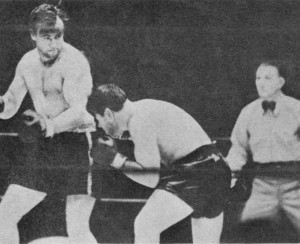
Maybe it was Walker’s finest hour. With brazen nerve he walked straight into the bigger man for three rounds. Then, as Jack re-gathered himself and began to land, an amazing see-saw battle unfolded. Toe to toe exchanges shook each man as the sheer physics of good man versus little was suspended by Walker’s dead game act of will.
Sharkey seemed to have the better of it, at last, but in the tenth and eleventh, the smaller fighter dug down and held his own. Then, in the twelfth, Sharkey staggered his man. Seeing his chance Jack went for broke. Wobbled, and wobbled again, Mickey refused to fall. In the 13th and 14th he kept coming, and the fight was still up for grabs. When Walker staged a rally in the fifteenth, the crowd went into a delirium. Each man was throwing at the close, and no one was confident of the outcome when the bell sounded.
The two ringside judges had it one for Sharkey and the other even. Referee Arthur Donovan, the man closest to the action, had it 11 – 4 Walker. Thus it was a three-way split on the vote, and the fight was a draw.
If Jack lost any luster in failing to stop the smaller fighter, he gained some consolation when he defeated Schmeling on points to win the heavyweight title in their return fight eleven months later. Walker, at the height of his heroic ride, continued into 1932 with more wins before dropping a close nod in a rematch with Johnny Risko.
The wins that year included an April ten-round decision in front of 20,000 yelling fans at the Chicago Stadium over light-heavyweight contender Harris Kracow – aka Kingfish Levinsky, a colorful character, managed by his tough-talking sister, who had grown up on the West Side in a family of local fish peddlers. The King might not have been the craftiest man in his division, but he could sock, and he always drew a crowd. Again Walker found himself in a tough spot. Near the end of the first round the King sprawled him with a left hook. Up by instinct without a count, he wandered in a daze to Levinsky’s corner when the bell sounded. From that point it was another nip and tuck battle, with Walker charging the cannons and heaving all he had.
In the end, it was a quintessential Walker victory. Mickey won, said one observer, “because of his experience, his ringcraft and his ability to sink a murderous left hook deep in the pit of the Kingfish’s stomach.” (New York Daily News, 4-30-32) It was a nice summation not only of the fight, but of much of Walker’s ring career.
But at what cost was another question. The punishment, while Mickey could take it by the truckload, was mounting with time. The following month he still had enough left to get the nod over Spanish heavyweight champ Paulino Uzcudun, who had gained notoriety with a 20-round win over the savagely hard-hitting heavyweight contender Max Baer. From a distance, in fact, it looked like Walker – still a natural middleweight – could hold his own with any man in the world. Then, on September 26th he finally reached too far when he entered a Long Island City ring in a scheduled 15-rounder against former heavyweight champion Max Schmeling.
Again it looked like a ridiculous mismatch, and this time the worst fears were realized. Walker’s troubles began a week before the fight, when he suffered a cut during some horseplay with Kearns that pushed back the meeting two weeks. In the 20 days that followed, he gained pounds and entered the ring at a bloated 172.
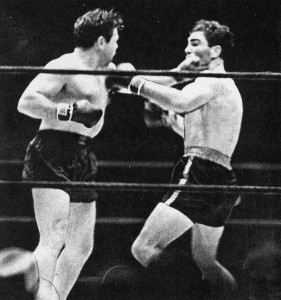
Still, it might not have made any difference. The fight, scribe Paul Gallico would declare the next morning, was like unto a scene from a slaughterhouse. In the first round, a right hand, Schmeling’s bread and butter weapon, nearly closed Walker’s left eye. Mickey fought on for several more rounds, taking punches that might have dropped anyone else in the game, until the gates of hell opened under him.
In the seventh, Schmeling’s left hand closed Walker’s right eye. In the eighth, Max hammered the smaller man pillar to post. Down went Mickey from a right hand – the same overhand bomb that would knock out a young Joe Louis four years later at Yankee Stadium. Twice more he fell with blood running from his mouth. Nearly blind and practically unconscious, he got up and made it to the bell. But Kearns would let it go no further.
An amazing show of bravery, it was certainly also the worst beating that Walker would ever take. worst beating that Walker ever took. Now some supposed that The Toy Bulldog was done. In fact, he was never quite the same again, yet more paydays loomed. His first time back he scored a first round knockout of Belgian heavyweight Arthur De Kuh that December. Two more fights followed, but the wide-reaching Kearns, it seemed, was more interested these days in California politics than in the fight game.
For a time, he and Walker parted ways. They reunited months later, and in November of 1933, Mickey dropped a 15-round decision to Max Rosenbloom in a fight for the light-heavyweight title. Yet Kearns was able to secure another go with Max, a ten round non-title fight, in the following spring. And Mickey, the kid who would never say die, came away with the win.
For all intents, it was his last hurrah. At this point keeping the fighter focused and off the bottle was getting even harder. Kearns saw the writing on the wall. He and Mickey parted, this time for good, with mutual warm wishes. At 34, and with many rugged miles behind him, Mickey himself now sensed that the ride was over. But finding another career at this point proved to be no easy task. That August, when he dropped a decision to Young Corbett III in San Francisco, it seemed that there was nowhere left to go. Then one day he received a visit from Big Bill Duffy, owner of the Silver Slipper, who had learned that he and Jack had gone their separate ways. Playing on Mickey’s ego and his deepest hopes, he convinced the fighter that there was still something left in his tank.
That October Mickey went against Natie Brown, who had recently gone the ten round distance with Joe Louis. Nate and Mickey went ten rounds to a draw. The next month Walker dropped a decision to up and coming Philadelphia light-heavyweight Paul Pirrone. A win later that month got him a rematch with Pirrone, but to no avail. In the eleventh round, the Toy Bulldog went down for the count.
In February he and Duffy opened the Toy Bulldog Saloon in New York across from Madison Square Garden. It did a flourishing business, even as Mickey sank deeper into the booze all the while. He spent his days hanging out with celebrities and tough guys who frequented the place and stayed away from Clara for months at a time.
And still he fought on – after an initial loss, he ran off six wins that year, and thanks to a mad pipe dream of Duffy’s, he was close to getting a fight with Joe Louis, who had just recently cut down the deposed champion Max Baer. It was Walker’s good fortune to meet European champion Eric Seelig late that November before the wild plan could be realized. After being stopped by Seelig, Mickey decided, once and for all, to hang it up.
The next few years brought a few forays into the stage and film industry, projects that allowed Mickey to vent the “ham” in his Irish soul that he could never quite suppress. In 1939, he and Clara divorced after a two year separation. Mickey married his girlfriend Eleanor Marvil and continued his stage and nightclub bits while nearly drinking himself into the ground.
One night, a confrontation with a mindless drunk in a bar gave him the epiphany that he needed. Ready to flatten the nuisance, he stopped instead and eyed him for a second. At that moment there came another life-shaking epiphany: He realized what he himself now looked like to everyone around him.
“Thanks, friend,” he said. “You don’t know it, but you just did me a hell of a favor.” Turning to the bartender, he added, “Eddie, lend me twenty bucks and give everybody in the house a drink. It’s on me. I’ll never take another as long as I live.” And that was that.
* * *
In the summer of 1941, living quietly in his old home town, Walker had another awakening, one that would fill him with passion ever after. Indeed it would win him genuine celebrity all over again. One evening he and Eleanor were at the local theater watching The Moon and Sixpence, a film based on Somerset Maugham’s story of the French painter Gauguin. As Mickey watched, he became entranced. Just how did a man capture timeless beauty by slapping bright shades of oil onto a piece of canvas?
A couple of days later, sitting alone half-way through his third viewing of the film, he jumped up and headed for an art store there in Elizabeth. He wanted everything that a real artist needed to put together a masterpiece. After laying out some two hundred bucks for the equipment, however, he decided upon one caution. Remembering the ridicule he received from friends years earlier, when they had caught him dabbling in poetry, he said to the fellow behind the counter, “Don’t tell anyone about this – if I find out that you did, I’ll break your jaw.”
This new interest was no mere infatuation. He followed through on it the same way that he had pursued his ring career, and the same way that he had ended the drinking. In its own way, he soon discovered, this new activity was as hard as fighting. He saw that there was more to being a painter than most people ever imagine. Unable to find direction, he called upon an old friend Maxwell Simpson, with whom he had trained at the YMCA gym while in his teens. Simpson had ventured to Paris in later years where he studied painting, and by now he was one of America’s premier artists. It happened that he, too, was back in the old neighborhood only a couple of blocks away. It was a long and difficult process, but as the breakthroughs came, Walker attacked that upright canvas with his own unique ferocity.
On December 7th, however, a good many ambitions were curtailed across the country when the Japanese attacked Pearl Harbor. Unable to qualify as an Air Force gunner, Mickey opted for a much tamer assignment in the USO. He returned home to Elizabeth, when the tour of duty was over, to watch over his saloon, a place neatly called The First Round.
And the crazy fascination of a weathered ex-pug with world-class art continued. Portraits, landscapes, still life scenes – with money rolling in from the saloon, and his own drinking days behind him, he now painted from early morning to day’s end, often arising in the middle of the night to start work and missing many a meal as projects continued to swallow him.
Before long he had some thirty finished pieces, many adorning his living and dining room walls. When his friend, sports columnist Bill Corum, paid a visit, he self-consciously pulled them down and stuck them in the closets. He had missed a six-by-ten inch landscape, however, and at one point in the evening it caught Bill’s eye. Leaving his chair to take a closer look, Corum saw the signature. He was astounded. He then pleaded to see the others – what kind of miracle had he discovered here? Finally convincing the uneasy fighter that he was serious, he arranged an art exhibit in the spring of 1944 at the Waldorf-Astoria Hotel and gained magazine and newspaper coverage to accompany it. Newsreels were rolling.
Perhaps nothing like it had occurred in the history of civilized mankind – here were gathered Park Avenue critics rubbing elbows with folk from Keighry Head and Broadway – a motley and massive mix of fighters and dock men, artists and con artists, shills, jockeys, and intellects, some of the rougher types borrowing or purloining tuxedos for the occasion. It was a strangely rousing event, each element of the crowd intrigued by all of the others. In the thick of it stood Walker’s pal, the formidable Two Ton Tony Galento, a 5’9, 220-pound marvel who had come close to winning the heavyweight title a few years earlier. Wryly sporting monocle, beret, and smock, the barrel-waisted veteran was doing his best to render leg-pulling lines like, “The perspective is distorted and the subordination of technique to composition is indubitably fatuous.”
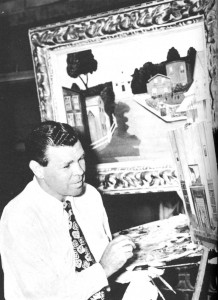
Less than a year later, Walker had another one-man exhibit arranged by the American Associated Artists Galleries on Fifth Avenue. Serious compliments were now being paid, and the works were selling at good prices. Shortly before Christmas of 1947, his old partner Kearns pulled a publicity stunt by asking Walker to send him one of the paintings, supposedly for the sake of dressing up his showroom at a Lincoln Continental agency in Chicago. Receiving a piece from Mickey called December Masquerade, Doc entered it in a contest at Marshall Field Galleries where it took first prize and its creator was awarded a five-thousand dollar prize. (Years later, Walker heard that Jack had sold the painting for triple that figure.)
The former middleweight champion of the world was now an accomplished artist, yet the painting was becoming not merely a hobby, but an obsession. By this time he was divorced from Eleanor and remarried to Clara, and that marriage, too, would crumble when Clara decided that art had become, as she put it, her husband’s new mistress.
In 1948 Mickey demonstrated one more of his talents when he became sports editor of the longtime weekly Police Gazette. In 1955, he would divorce Maude a second time (in all, he would have seven marriages to four women), at which point he determined to have no more serious involvement with members of the fair sex. One day, however, his life would take an unexpected turn when he was lured to New York by John Carney, head of the Gazette, supposedly to work on a series for the paper.
As it turned out, what Carney wanted was a partner and a host for an upscale restaurant and bar that he would call The Glove and Palette. Some of those paintings, he figured, would make an ingenious décor. The opening was a smash hit, and Walker was in business again. Still, the assignment was a tough one – even if he wasn’t drinking, Mickey was staying out at all hours. It wasn’t his style any more.
And then one day an old cohort, former featherweight great Abe Attell, came into the joint with a stunning blonde named Martha Gallagher. At 54, the Irish kid was smitten all over again. Less than a month later, in January of 1956, he and Martha took the vows. Mickey, all the while sober, connected with a job selling liquor for National Distillers. It worked out well, and he succeeded, for the first time in a very long while, in keeping his home life in one piece.
* * *
The old champion, to no surprise, had strong thoughts about his sport when he penned his own story in later years. He believed, at the age of sixty, that he could hold his own (maybe not for ten rounds, but for three) with some of the best in the business. Like every aging warrior, of course, he favored the men of his time over the current crop. But he offered cogent reasons: The advent of living room television, he maintained, had undercut the development of new talent by taking away patronage from the small clubs where young fighters traditionally made their rise. Softer lifestyles, too, were taking a daily toll on the drive and fortitude of the new generation.
Of his life there is more to tell – Mickey would live on another 25 years, with more ups and downs, before passing in 1981 at a convalescent home in Freehold, New Jersey. Late in life, like a good many men in his unforgiving trade, he was afflicted with Parkinson’s disease. But his happy time with Martha is perhaps a better note on which to wind down this present telling of his story. And a worthy epitaph might be the words that close his own published remembrances – Live today, he advised his reader, forget yesterday, and have hope for tomorrow.
_____
I wish to thank Harry and Raven Shaffer for providing helpful archival materials related to Walker’s life and career. Direct quotes not attributed to sources elsewhere are taken mostly from Walker’s memoir, co-authored with Joe Reichler, entitled Mickey Walker – the Toy Bulldog and His Times (New York: Random House, 1961). An excellent summary of Walker’s career, with film footage provided, is available at TheBoxingMagazine.com. For recent commentary on the alleged “second” Greb – Walker fight, see Bill Paxton’s extensive work The Fearless Harry Greb – Biography of a Tragic Hero of Boxing (Jefferson, NC: McFarland & Company, Publishers, 2009). KN
